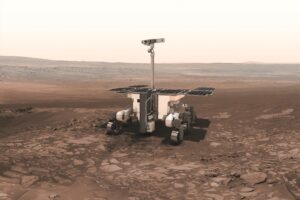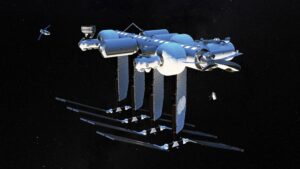ESA suspends work with Russia on ExoMars mission
Thursday, 17 March 2022 13:45
ESA has formally halted plans to launch its ExoMars mission on a Russian rocket in September in response to Russia’s invasion of Ukraine.
The post ESA suspends work with Russia on ExoMars mission appeared first on SpaceNews.
Op-ed | Order and Progress – Brazil’s Second Act in Space
Thursday, 17 March 2022 12:29
As the pieces of Brazil’s modern space ecosystem slide into place, the country isn’t just now waking up to the value and potential in the space ecosystem. It is entering its “second act.
Sierra Space to work with Mitsubishi Heavy Industries on commercial space station technologies
Thursday, 17 March 2022 12:00
Sierra Space and Mitsubishi Heavy Industries (MHI) have signed an agreement to study collaboration on technologies to support a planned commercial space station.
The post Sierra Space to work with Mitsubishi Heavy Industries on commercial space station technologies appeared first on SpaceNews.
ExoMars suspended
Thursday, 17 March 2022 09:57Press Release N° 9–2022
As an intergovernmental organisation mandated to develop and implement space programmes in full respect with European values, we deeply deplore the human casualties and tragic consequences of the aggression towards Ukraine. While recognising the impact on scientific exploration of space, ESA is fully aligned with the sanctions imposed on Russia by its Member States.
Spire Global signs deal with NorthStar Earth and Space for a dedicated constellation
Thursday, 17 March 2022 09:04 Spire Global, Inc. (NYSE: SPIR) has announced a new space-as-a-service agreement with NorthStar Earth and Space ("NorthStar"), a comprehensive Earth and Space Information Services Platform, to build a constellation of satellites focused on space-situational awareness (SSA) and debris monitoring. The first award within the contract is for three satellites, with pre-agreed options for NorthStar to
Spire Global, Inc. (NYSE: SPIR) has announced a new space-as-a-service agreement with NorthStar Earth and Space ("NorthStar"), a comprehensive Earth and Space Information Services Platform, to build a constellation of satellites focused on space-situational awareness (SSA) and debris monitoring. The first award within the contract is for three satellites, with pre-agreed options for NorthStar to Beyond Gravity boosts its capacity for satellite dispenser systems in Linkoping and creates 60 new jobs with new production facility
Thursday, 17 March 2022 09:04 Beyond Gravity (formerly RUAG Space) is significantly ramping up its production of satellite dispensers in Linkoping, Sweden, with the construction of a new facility. It will be used to produce dispensers for satellite constellations. With the new building, Beyond Gravity is doubling its production capacity for satellite dispenser systems and creating 60 new jobs in Linkoping. The groundbreaking
Beyond Gravity (formerly RUAG Space) is significantly ramping up its production of satellite dispensers in Linkoping, Sweden, with the construction of a new facility. It will be used to produce dispensers for satellite constellations. With the new building, Beyond Gravity is doubling its production capacity for satellite dispenser systems and creating 60 new jobs in Linkoping. The groundbreaking Celestia Aerospace closes 100M euro seed round with London-Based Invema Ltd
Thursday, 17 March 2022 09:04 Invema Group LTD, with headquarters in London and international offices in Arizona (USA), Miami (USA), Toronto (Canada), Bogota (Colombia), Casablanca (Morocco), Tunis (Tunisia), Riyadh (Saudi Arabia) and Dubai (United Arab Emirates), invests 100 million euros in the orbital solutions company Celestia Aerospace located in Barcelona.
With this investment round, Celestia Aerospace launches a
Invema Group LTD, with headquarters in London and international offices in Arizona (USA), Miami (USA), Toronto (Canada), Bogota (Colombia), Casablanca (Morocco), Tunis (Tunisia), Riyadh (Saudi Arabia) and Dubai (United Arab Emirates), invests 100 million euros in the orbital solutions company Celestia Aerospace located in Barcelona.
With this investment round, Celestia Aerospace launches a Astranis Space Technologies first MicroGEO Satellite completes final testing
Thursday, 17 March 2022 09:04 Astranis Space Technologies Corp. has announced that the first MicroGEO satellite is ready for launch after successful completion of final testing.
Astranis has now completed all major tests necessary for its first MicroGEO spacecraft to be ready to ship to the launch site, including vibration and vibroacoustic tests, final solar array and antenna deployment tests, propulsion system tests, soft
Astranis Space Technologies Corp. has announced that the first MicroGEO satellite is ready for launch after successful completion of final testing.
Astranis has now completed all major tests necessary for its first MicroGEO spacecraft to be ready to ship to the launch site, including vibration and vibroacoustic tests, final solar array and antenna deployment tests, propulsion system tests, soft China launches second Yaogan-34 reconnaissance satellite
Thursday, 17 March 2022 09:01
A Long March 4C rocket sent a new classified Yaogan satellite into orbit Thursday, marking China’s sixth orbital launch of 2022.
NASA extends Ingenuity Helicopter Mission
Thursday, 17 March 2022 03:18 NASA has extended flight operations of the Ingenuity Mars Helicopter through September. In the months ahead, history's first aircraft to operate from the surface of another world will support the Perseverance rover's upcoming science campaign exploring the ancient river delta of Jezero Crater. Along the way, it will continue testing its own capabilities to support the design of future Mars air v
NASA has extended flight operations of the Ingenuity Mars Helicopter through September. In the months ahead, history's first aircraft to operate from the surface of another world will support the Perseverance rover's upcoming science campaign exploring the ancient river delta of Jezero Crater. Along the way, it will continue testing its own capabilities to support the design of future Mars air v ISS crews prepare for flow of visitors, rotations over next month
Thursday, 17 March 2022 03:18 Crews on the International Space Station (ISS) will cope with almost unprecedented human congestion as 18 astronauts and cosmonauts arrive, work and depart from it over the next month, NASA ISS Operations Integration Manager Dina Contella said.
"[The] Soyuz launch on schedule on Friday [is] bringing three Russian crew members to the ISS and then returning [on March 30] with three ISS crew
Crews on the International Space Station (ISS) will cope with almost unprecedented human congestion as 18 astronauts and cosmonauts arrive, work and depart from it over the next month, NASA ISS Operations Integration Manager Dina Contella said.
"[The] Soyuz launch on schedule on Friday [is] bringing three Russian crew members to the ISS and then returning [on March 30] with three ISS crew India maps out plan to increase satellite launches
Thursday, 17 March 2022 03:18 The Indian National Space Promotion and Authorisation Centre (INSPACe) has started hiring people for top posts at the Indian Space Research Organisation (ISRO) to take on new space missions and increase the manufacturing and launch of satellites.
The Indian Space Research Organisation (ISRO) is all set to take its missions to another level with an increase in the number of satellite manufa
The Indian National Space Promotion and Authorisation Centre (INSPACe) has started hiring people for top posts at the Indian Space Research Organisation (ISRO) to take on new space missions and increase the manufacturing and launch of satellites.
The Indian Space Research Organisation (ISRO) is all set to take its missions to another level with an increase in the number of satellite manufa Developing design tools for outer space structures
Thursday, 17 March 2022 03:18 West Lafayette IN (SPX) Mar 17, 2022
Achieving affordable space exploration will require lightweight structures for vehicles, solar arrays and antennas. Lightweight materials also will be used for components of structures like pressurized habitats, cryogenic tanks, landing gears and truss cages.
The problem is that NASA envisions that many of those structures will be made from tailorable
West Lafayette IN (SPX) Mar 17, 2022
Achieving affordable space exploration will require lightweight structures for vehicles, solar arrays and antennas. Lightweight materials also will be used for components of structures like pressurized habitats, cryogenic tanks, landing gears and truss cages.
The problem is that NASA envisions that many of those structures will be made from tailorable Carrier rocket preparing for its debut flight
Thursday, 17 March 2022 03:18 Smart Dragon 3, a new model of solid-propellant carrier rocket, is scheduled to make its debut flight in September, according to a senior rocket scientist.
Engineers at the China Academy of Launch Vehicle Technology, the country's major rocket maker, are building the first Smart Dragon 3, which will be launched for the model's first mission, said Jiang Jie, a senior rocket scientist at the
Smart Dragon 3, a new model of solid-propellant carrier rocket, is scheduled to make its debut flight in September, according to a senior rocket scientist.
Engineers at the China Academy of Launch Vehicle Technology, the country's major rocket maker, are building the first Smart Dragon 3, which will be launched for the model's first mission, said Jiang Jie, a senior rocket scientist at the China tests rocket engine for upcoming space lab launches
Thursday, 17 March 2022 03:18 A Chinese high-thrust oxyhydrogen rocket engine has completed a 520-second test in preparation for the upcoming launches of space station lab modules, its maker said on Wednesday.
Developed by the China Aerospace Science and Technology Corporation, the engine is designed for the core stage of the Long March-5 carrier rocket series, which will be used to launch two lab modules of China's or
A Chinese high-thrust oxyhydrogen rocket engine has completed a 520-second test in preparation for the upcoming launches of space station lab modules, its maker said on Wednesday.
Developed by the China Aerospace Science and Technology Corporation, the engine is designed for the core stage of the Long March-5 carrier rocket series, which will be used to launch two lab modules of China's or 
